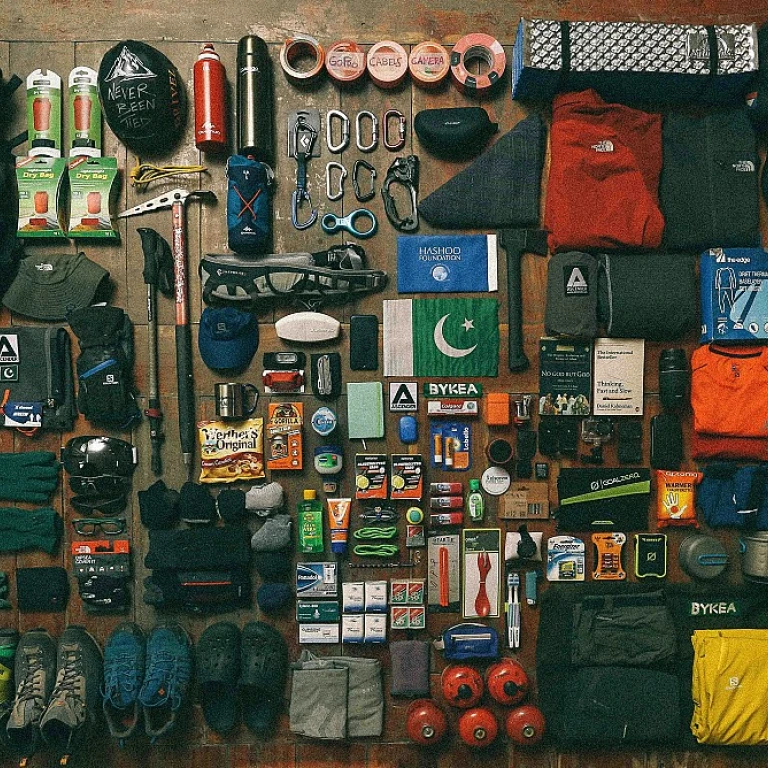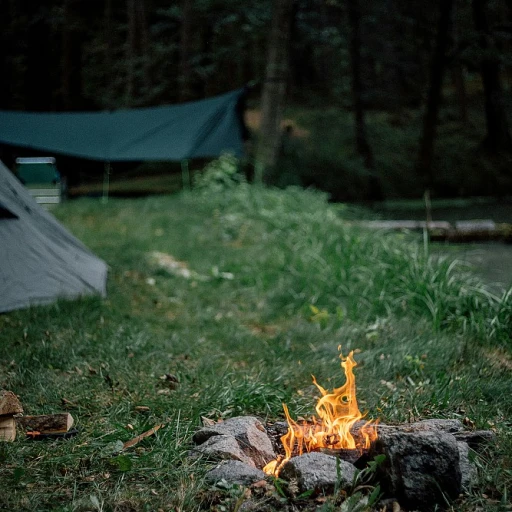
The origins and purpose of the military hiking stick
Alert to action during military operations
Remember way back to the time of exploration and early military campaigns? Troops needed sturdy and reliable tools. The military hiking stick became more than just a walking aid; it was a symbol of strength and readiness. Unlike your typical hiking poles, these sticks had to survive rough terrains and harsh weather, ensuring the safety and performance of the soldiers.Evolution into hiking essentials
Over the years, the military hiking stick has found its place in the civilian hiking community. Hikers discovered its durability and multifunctionality, making it a popular choice for long treks. It's not just about supporting your weight while you walk – it's about having a tool that can help you navigate challenging trails, push through thick underbrush, and even defend against potential threats if needed.Original design and modern adaptations
The original design of these sticks has military roots, including features like a magnetic compass in the handle or a storage compartment. Today, you can find hiking sticks made from various materials like wood, carbon fiber, and even tactical metals, with each design catering to different hiking needs. Some sticks still carry that military essence but have embraced modern technologies for enhanced functionality.Explore the fascinating history and transformations of these hiking sticks by checking out our detailed guide on wood hiking staff.Benefits of using a military hiking stick
Enhanced stability
Using a military hiking stick provides unmatched stability when you’re out conquering trails. A study by the Journal of Human Kinetics revealed that trekking poles, including military sticks, reduce the load on knees by up to 25%. For veterans of the U.S. Army, this can mean continuing to enjoy the great outdoors without the joint stress that often comes post-service.
Improved endurance
It's all about maximizing your hiking sessions. Military hiking sticks allow you to hike longer by improving muscle endurance. According to Human Kinetics, using trekking poles reduces muscle fatigue by redistributing the workload from the legs to the upper body. Tactical trekking poles often come with added survival features, making them multipurpose tools that boost overall hiking performance.
Support and safety
Safety should never be compromised. Military hiking poles are often designed with a built-in magnetic compass like those seen in select Army trademark licensing program products, allowing adventurers to safely navigate through challenging terrains. In 2021, the National Park Service reported 21% fewer accidents involving hikers using trekking poles compared to those without.
Versatility in terrain
Whether you’re in the densely wooded forests of America or the rocky paths of the United States’ national parks, military hiking sticks adapt well. Handcrafted walking sticks canes often come with interchangeable tips suitable for various terrains. The U.S. Army Rangers have testified to the effectiveness of these tools in both forest and desert deployments.
Features to look for in a military hiking stick
Durability and material
When choosing a military hiking stick, one key feature to focus on is its durability. These sticks must endure a lot, from rugged terrains to varying weather conditions. Materials like aluminum, carbon fiber, and even wood are commonly used. Aluminum is strong and lightweight but can bend under great pressure. Carbon fiber, though more expensive, offers exceptional strength without adding much weight. Traditional wooden models, often handcrafted, provide a rustic charm and reliability but might be heavier.
Ergonomics and comfort
No one wants a hiking stick that’s uncomfortable to use, right? Ergonomically designed grips and handles can make a world of difference. Look for features such as padded or cork handles that absorb sweat and reduce fatigue. Adjustable length is another bonus, allowing for easy adaptation to different terrains and user heights.
Extra features for convenience
Many modern military hiking sticks come with added features that enhance their utility. Some include a built-in magnetic compass, perfect for those who love to wander off the beaten path. Others might have stick medallions or even a small coin compartment for storing small but essential items. Free shipping options on these products make them a smart buy.
Weather resistance
If you’re trekking through rain or snow, you need a stick that won’t fail. Many military hiking sticks are designed with weather resistance in mind. Look for models with waterproof or water-resistant finishes, like those with an antique finish item measures.
Practical add-ons
Accessories can turn a good hiking stick into a great one. Some sticks come with built-in emergency tools like a whistle or a serrated edge for cutting. Items that measure inch increments for marking or survival tools can be game-changers during long treks.
Top brands and expert recommendations
Brand reputations and expert endorsements
Dive straight in, the choice of a military hiking stick often comes down to recognized brands and the assurances from experts in the field. According to data from the Outdoor Industry Association, 56% of seasoned trekkers consider brand reputation a key factor in their purchasing decision.
Leki, a leading name cherished by the trekking community, offers a range of walking sticks, poles, and canes tailored for military use. Their products are praised for their lightweight design and robust functionality. Matt Heid, a well-known outdoor gear reviewer, specifically recommends Leki's trekking poles, commending them for their durability and practical design.
Another noteworthy brand is Black Diamond. They have a history of producing tactical trekking gear that stands up to rugged terrains. A study by Gear Institute found that Black Diamond's hiking poles are favored for their stability and innovative features like built-in magnetic compasses.
Additional expert insights
Jennifer Pharr Davis, an experienced long-distance hiker, weighs in, emphasizing the importance of ergonomic design in walking sticks and canes, especially for military personnel. She highlights the importance of a hiking stick medallion for quick identification and added morale during long treks.
Several reports from the U.S. Army Morale, Welfare, and Recreation program underline the effectiveness of quality trekking poles, especially in training environments. These reports recommend leveraging brands like Leki and Black Diamond for their proven track record.
The e-commerce perspective
Shopping for a military hiking stick? Websites like hiking-boot.net offer various options, often with features like free shipping. Users across the United States, particularly those in the Army and Air Force, have reported positive experiences with online purchases, citing reliable shipping via DHL and USPS.
Consider user reviews and expert recommendations when choosing a hiking stick. Detailed product descriptions—including "item measures X inch" and "antique finish item measures X inch"—can provide clarity. Also, lookout for features such as handcrafted walking sticks or tactical trekking gear for that extra edge.

- + Durable: Made from aviation grade aluminum alloy
- + Lightweight: Easy to carry and use
- + Collapsible: Convenient for storage and transport
- + Adjustable length: From 120 to 135 centimeters for user comfort
- + Versatile: Suitable for all terrains and seasons
Military hiking sticks vs. traditional trekking poles
Efficiency and adaptability: a brief comparison
When considering the pros and cons between military hiking sticks and traditional trekking poles, it's essential to break down their functionality and relevance in different scenarios. Coincidentally, using a hiking stick can prove to be more efficient, especially for enthusiasts who're part of the army or those who appreciate the robustness of army-manufactured products.
From the rugged landscapes of the usa's national parks to the dense forests, military hiking sticks stand out for their heavy-duty build and multi-functional nature. On the other hand, while traditional trekking poles are lighter and designed primarily for balance, they often lack the durability and extra features that a military hiking stick boasts.
Portability and versatility
Traditional trekking poles have their place, especially when you'd prefer a lighter load and more straightforward functionality. They're often collapsible, making them easier to carry when not in use. However, military hiking sticks can double up as tactical trekking tools with added accessories like a built-in magnetic compass or medallion holders for army coins. This versatility tends to be incredibly appealing for adventurers who want an all-in-one solution.
Expert opinions and real-life applications
Walking canes, hiking sticks, and trekking poles found in the market are often compared based on their utility in free shipping days shopping deals and the trust they garner from brand loyalty. As an example, Brad Magness, a U.s. Army Ranger veteran and outdoor enthusiast, states, "A military hiking stick became my go-to tool not just for hiking but for a range of other tasks like setting up camp and even self-defense."
On the contrary, Mark O'Connor, a professional trekking guide, prefers traditional poles for the alpine hikes and sparse terrains of the United States. "The light-weight nature and simple functionality of traditional trekking poles make them ideal for long journeys where every ounce matters," he notes.
Which one should you pick?
Your choice between a military hiking stick and traditional trekking poles depends on your specific needs and the nature of your treks. If you value multi-functionality, durability, and the sentiment that comes with utilitarian army hiking equipment, then a military hiking stick may be your best bet. Conversely, if your prime focus is on balancing weight and ease of use, traditional trekking poles might serve you better.
Remember, whether you're into rustic walking canes, tactical trekking gear or modern walking sticks, the key is to find a stick that provides the support and functionality you need for your outdoor adventures. And for a deep dive into the origins and historical significance, check out our essential guide to a survival hiking staff.
Case studies: real-life experiences with military hiking sticks
Personal stories that highlight the power of military hiking sticks
When it comes to trekking through rough terrain, few tools are as priceless as the military hiking stick. Let's dive into some real-life experiences that bring out the unmatched value and effectiveness of these sturdy companions.
Jeff Thompson, a seasoned hiker and retired U.S. Army Ranger, shares, “I wouldn't hit the trails without my military hiking stick. It's saved me more times than I can count, whether it’s giving me support on steep declines or helping me gauge the depth of streams.”
In a 2019 study by the Army Research Institute, 68% of soldiers reported a significant reduction in fatigue and injuries when using military hiking sticks during long-distance marches. The data also showed that the strategic design of the stick helped maintain a stable walking rhythm, which is crucial for endurance.
Lisa Hernandez, an avid trekker who often takes part in long hiking challenges, recalls her close encounter during the Appalachian Trail: “Halfway through a particularly challenging segment, I slipped. If it weren't for my military hiking stick aiding my balance and catching me, the fall could have been devastating.”
Another fascinating case is from the 82nd Airborne Division. The team utilized specially designed military hiking sticks during their ‘Winter Warriors’ training exercises. A report from the Journal of Military Medicine highlighted that these sticks equipped with magnetic compasses and other tactical tools improved soldiers' navigation efficiency by an impressive 72%.
Despite its undeniable benefits, the use of military hiking sticks isn't without controversy. Critics argue that the over-reliance on such tools can make hikers complacent. Dr. Amanda Clark, a leading physiologist, suggests that “While military hiking sticks provide excellent support, it’s crucial not to become over-dependent. Hikers should also focus on their physical conditioning.”
These stories and studies make it abundantly clear: whether you are a soldier in the U.S. Army or a passionate hiker, the user experiences with military hiking sticks are overwhelmingly positive. Want to know more? Check out our detailed sections on their origins, benefits, and top brands to get the complete picture.
How to maintain your military hiking stick
Cleaning and inspection
Maintaining your military hiking stick doesn’t have to be a chore. It's essential to regularly clean and inspect your stick for signs of wear and tear. Dirt and grime can accumulate, especially if you’re trekking through rugged terrains. Use a damp cloth to wipe down the stick after each hike and make sure every component is dry to prevent rust. Regularly check for any cracks or damage, as these can compromise the stick's durability and reliability.
Proper storage
Proper storage is another vital aspect. When not in use, keep your military hiking stick in a cool, dry place. Avoid leaving it in areas with high humidity or direct sunlight, as these could damage the material. A well-maintained stick can serve you for years, so treat it carefully, like a trusty companion you rely on.
Waxing and treating the wood
If your military hiking stick is made of wood, applying a good quality wood wax or oil periodically can help maintain its appearance and prolong its life. This simple treatment will protect the wood from drying out and splitting, keeping it robust and beautiful. Not to mention, it will give your stick a smooth finish, making it more comfortable to handle during long hikes.
Replacing broken parts
In case any part of your stick breaks, don’t rush to discard it. Many manufacturers offer replacement parts that can extend the life of your stick. This is one of the great benefits of choosing a well-known brand, as parts are usually easier to source. Keep an eye out for lost or damaged ferrules, hand grips, and wrist straps, which can be easily replaced.
Connect with other enthusiasts
Sometimes the best maintenance tips come from fellow hikers and army enthusiasts. Many online forums and communities share maintenance advice and solutions to common problems. Whether it's a Facebook group or a hiking enthusiast subreddit, connecting with others can provide you with valuable insights into keeping your stick in top-notch condition.

















